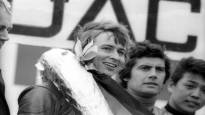What exactly happened?
Jarno Saarinen Even today, there is no 100% certain information about the events leading to death. The accident happened 50 years ago on the Monza motor track at a bend called Curva Grande, and there were no TV cameras.
The situation went something like this: the Italian Renzo Pasolini, who was second in the race, crashed in a curve at a speed of more than 200 kilometers per hour. Pasolini’s bike bounced off the track fence back onto the track. Saarinen did not have time to dodge. This resulted in a mass crash involving 14 drivers.
According to witnesses, several drivers drove over Saarinen. According to the doctor, Saarinen had died immediately.
The sad news was received heavily in Finland.
Saarinen was the world champion in the 250cc class of track motorcycling from 1972. He was 27 years old when he died.
What caused the accident?
Press corps Raimo Häyrinen and Reijo Suojanen tried to find out about it on the day of Saarinen’s death, May 20, 1973. They interviewed another Finnish driver on ‘s radio broadcast Teuvo Länsivuoren a mechanic Matti from Neuvo.
– Everything is messed up here. No one knows anything here, Neuvonen said by phone from Italy.
However, there were doubts.
– I feel that there has been oil on the track. The boys from the previous class said after they finished that there is oil everywhere on the track, Neuvonen said.
The oil on the track made the surface slippery. Today, this is considered the most plausible explanation for the accident, even though the race organizers claimed otherwise. According to them, the accident was caused by the engine of Pasolini’s bike cutting off.
You can listen to ‘s radio broadcast about Saarinen’s death and the interview with mechanic Neuvonen in full below.
By hearse to the pit
Jarno Saarinen rose like a comet to the top of track motorcycling. Saarinen and his life partner Soiled formed a power duo that made even the big factory stables tremble.
There is also an international TV series in the works about the lives of Jarno and Soil, the plot of which has plenty of hooks based on facts. Like, for example, the fact that their first transport vehicle in the world was a hearse.
– Yes, it was noticed and caused surprise when we arrived at the pit with a hearse, but we had no other option then. Otherwise, we wouldn’t have made it to Europe. Jarno’s family had a funeral home and we were able to borrow the company’s second hearse. It was such a beautiful Plymouth Belvedere, Soili Karme told Urheilu’s story last year.
In Finland, the two were allowed to travel in a van, but they could not go abroad with it.
– In Europe, we slept in the hearse and on the backboard we cooked food with a primus cooker, ate breakfast and made tea.
– We were a team of two. Jarno was a skilled mechanic and I did everything I could. I took lap times and showed the pit board. I also often drove the transporter at night so that Jarno could sleep. He called me his night eye. My job was also to keep the wheels clean and I was needed as a helper when changing the crankshaft.
World championship in Imatra
Everything changed after Saarinen won the world championship at Imatra.
– However, after the world championship was secured, the race organizers took us to spend the night in the tower apartment of the State Hotel. It was something big that I had always wanted, Soili Karme laughed.
A rally legend Markku Alén witnessed Jarno Saarinen’s big day in Imatra 50 years ago.
– I was in a motorcycle race for the first time then. That’s where my enthusiasm for two-wheelers began, as well as a strong appreciation for these guys, Alén told Urheilu last year.
– Jarno quickly developed to top speed. He would surely have won several world championships but for his fatal accident. He already had the ability to ride a motorcycle as a gift. He also knew the technical side and was able to put the bikes in even better condition than Yamaha’s factory mechanics, Alén praised.
In addition to his world championship, Jarno Saarinen, who drove twice to the World Championship silver and once to bronze, also left his own driving technical legacy to the sport. Today’s cornering technique, where the knee slopes the surface of the track, is based on the style Saarinen created in his time.
– It started with the fact that we had such bad tires. You had to “chirp” a bit to keep up with the others. Yes, others started to use that style, Teuvo Länsivuori described.
